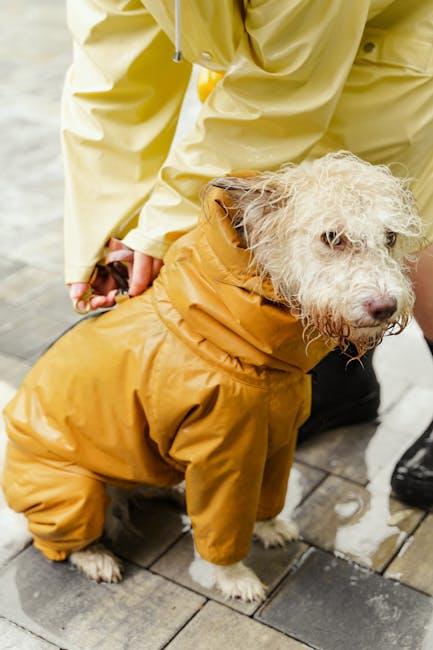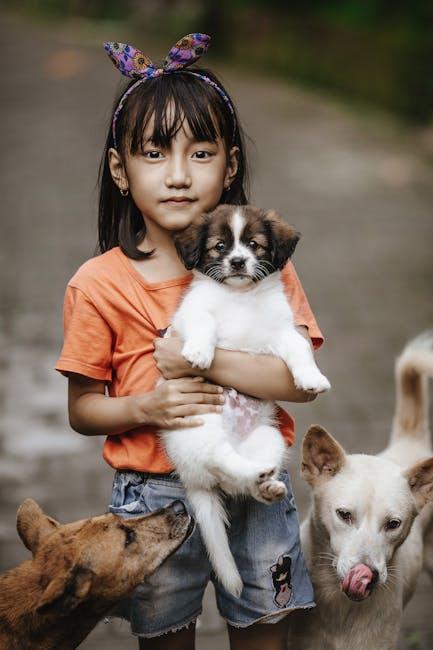Ensuring a harmonious relationship between your beloved dog and the children in your life is a rewarding yet crucial responsibility. As a pet owner, understanding the dynamics between dogs and children can help create a safe and nurturing environment for both. This article will guide you through practical steps and insights to foster positive interactions, safeguard against potential mishaps, and strengthen the bond between your furry friend and the little ones. With warmth and care, let us embark on this journey to keep your dog safe around children, ensuring peace of mind for you and a joyful experience for everyone involved.
Understanding Canine Body Language to Prevent Misunderstandings
Understanding your dog’s body language is essential for fostering a safe environment, especially when children are involved. Dogs communicate primarily through their bodies, using signals that can indicate comfort, stress, or the need for space. Recognizing these signals can prevent potential misunderstandings and ensure both the dog and children have positive interactions.
Some common signs to watch for include:
- Relaxed Body and Wagging Tail: A happy dog often has a loose, relaxed body and a wagging tail. However, be mindful of the tail’s position and speed, as a high, stiff wag can indicate excitement or agitation.
- Yawning or Lip Licking: These can be signs of stress or discomfort, not just tiredness or hunger. If your dog displays these behaviors around children, it might need a break.
- Pinned Ears and Cowering: These are clear indicators of fear or anxiety. It’s crucial to give your dog space and time to calm down if you notice these signals.
- Averting Gaze: A dog that looks away is often trying to avoid confrontation or signal submission. Teach children to respect this cue and not to force interaction.
By educating children about these signals and encouraging them to respect a dog’s space, you create a harmonious environment where both can coexist happily and safely.

Creating a Safe and Comfortable Environment for Your Dog and Children
Fostering a harmonious relationship between your dog and children requires careful planning and attention to both their needs. Begin by setting clear boundaries that are easy for children to understand and respect. Teach your kids the importance of giving the dog space, especially during mealtimes and when the dog is resting. Encourage them to use a gentle tone and slow movements when approaching or playing with the dog.
Incorporate interactive playtime activities that involve both your dog and children, such as fetch or hide-and-seek, which promote bonding and exercise. Consider creating a designated safe zone for your dog where it can retreat if feeling overwhelmed, ensuring it’s off-limits to children during these times. Additionally, make sure your dog is well-socialized and comfortable around kids by gradually introducing them in controlled settings. Remember to supervise interactions, providing guidance and reassurance as needed. This structured approach will nurture a safe and loving environment for everyone involved.

Teaching Children the Right Way to Interact with Dogs
Ensuring that children know how to interact with dogs not only helps in fostering a lifelong bond but also keeps both the child and the pet safe. Children should be taught to approach dogs calmly and quietly, avoiding sudden movements or loud noises that might startle them. Encourage them to let the dog sniff their hand before attempting to pet, which helps the dog feel more comfortable and familiar with their presence.
- Never disturb a dog while it’s eating or sleeping. Teach kids that these are times when dogs prefer to be left alone.
- Show them how to gently stroke a dog on its back or side, rather than patting its head or pulling on its tail or ears.
- Educate children on reading a dog’s body language. Recognizing signs of discomfort, such as growling or a tucked tail, can prevent unwanted incidents.
- Supervise all interactions between young children and dogs to ensure safety and provide guidance.
By instilling these habits, children will learn to respect dogs as sentient beings with their own needs and boundaries, paving the way for a harmonious relationship.

Recognizing Signs of Stress in Your Dog and How to Respond
Understanding your dog’s body language can be crucial in ensuring their well-being, especially in environments with children. Dogs often exhibit subtle cues that indicate they are feeling stressed or overwhelmed. Look for signs such as:
- Panting excessively or drooling more than usual
- Ears pinned back or a tucked tail
- Yawning frequently or licking their lips
- Avoiding eye contact or turning their head away
- Pacing or restlessness
When you notice these signals, it’s important to respond with calm and reassurance. Create a safe space for your dog to retreat to, away from the noise and activity of children. Encourage gentle interactions and teach children to respect your dog’s personal space. Providing your pet with their favorite toy or a treat can also help redirect their focus and reduce stress. Remember, a little understanding and patience go a long way in fostering a harmonious relationship between your furry friend and the young ones.

